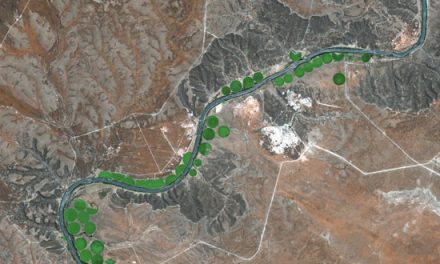
!Aimab Superfarm set to double output in three years with new tech investment

By Clifton Movirongo.
Namibia Dairies’ !Aimab Superfarm near Mariental is set to double production after investing in sustainable technology, with the goal to increase milk production to 60,000 litres per day by 2025.
The farm produces on average 31,500 litres of milk per day and wants to increase that capacity to 60,000 litres. The farm has about 700 milking cows out of a total dairy herd of approximately 1400 animals and is led and managed by a team of 90 trained technicians.
The unit production is on average 36 liters per cow per day, with all cows milked three times per day at 4 am, 12 pm, and 8 pm from Monday to Saturday, all year round. In addition, the farm produces hormone-free milk and follows strict processes and procedures to ensure the best quality dairy products. Dairy cows on this farm are specifically bred to produce large quantities of milk.
Meanwhile, heifers are raised on the farm until they reach the appropriate age and weight to reproduce, according to the farms’s staff responsible for the breeding herd.
“Dairy cows on the !Aimab Superfarm are treated to the nutritional and natural goodness grown on the farm resulting in healthy, hormone-free milk. Our employees give special attention to our cows by keeping them clean, cool, and comfortable,” said the Herd Manager, Neville Hembapu.
Furthermore, Hembapu, who has been employed at the Superfarm for about 10 years, said the good thing about dairy farming is that it provides an opportunity to learn something new every day, adding that there are new technologies evolving all the time to employ to get the job done.
Hembapu also noted that the dairy farm is constantly searching for innovations to increase milk yields, enhance milk quality, and reduce costs. He said technology assisted the sector and its stakeholders in many ways.
The farm has technologies such as robotic milking, which allows farmers to minimize the need for physical labour, maintain a sanitary milking process, and increase milk output. Dairy farmers must continue to improve production, promote animal health and product quality, and save time and energy on the farm, Hembapu said.
The cows are milked in the leading-edge milk parlour, and afterwards the milk is tanked to the manufacturing and processing plant in Windhoek. “Here, it undergoes pasteurization and filling under the strictest quality controls and standards,” he explained.
Richard Mutafela, an animal nutritionist and feed safety engineer at Superfarm, said that 60% of all feed is supplied from Superfarm’s own lands and 40% from external feed suppliers.
“At Superfarm, we have different groups of animals, each having a specific way it is fed depending on the amount of milk they produce and their stage of production,” he said, adding that they need to ensure they follow an appropriate and accurate feeding schedule.
Superfarm has a 12-month herd growth rate of 16% compared to the industry’s average of 4%. Concerning herd health and genetics, the !Aimab Superfarm operates only on industry best standards, according to the company.
NamWater supplies the Superfarm with water that comes from the Hardap Dam. According to Mutafela, temperature-regulated trucks ensure that the milk is kept as fresh as possible from the time it leaves the farm to the factory in Windhoek, where they test about 37,000 liters of milk per day for freshness before it is processed at their manufacturing plant in Avis outside Windhoek.
Namibia Dairies said it has grown into a leading force in the Namibian dairy industry and employs over 700 people at its main production plant in Windhoek, the !Aimab Superfarm in Mariental and various depotsacross Namibia.











































